中职英语教学设计比赛-教案-获奖future-life--听说课
职业英语教学设计比赛教案一等奖获奖futurelifetraffic听说课
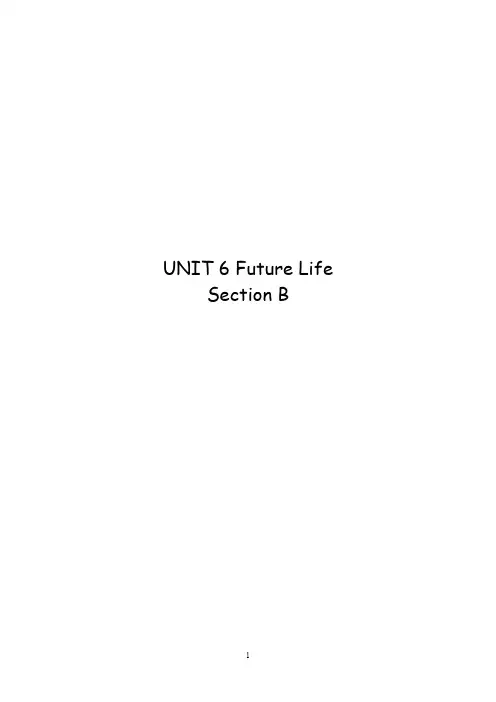
UNIT 6 Future LifeSection BUnit 6 Future LifeSection B【教材分析】本课是浙江省中等职业学校课本《英语》第二册第六单元听说课。
本课时的重点是通过听关于找工作和职业规划的对话,使学生能使用与职业及职业规划相关的词汇和句型,谈论职业规划。
为跟学生未来的就业有进一步的联系,教师设计了规划职业小窍门这一环节,帮助学生用英语讨论并介绍自己能从事的职业和未来10年的职业规划。
【学情分析】笔者所任教班级为电子商务专业,学生词汇量偏少,在正确使用英语句子会话上也存在较大困难。
因此教师用“找一找”、“连一连”分步帮助学生复习和学习词汇,用先短篇后长篇的阶梯式降低对话难度,提高学生的掌握率。
教师用学生熟悉、喜爱的著名主持人—汪涵的17年职业奋斗史,增加课堂趣味性。
仅中专毕业的汪涵,通过自己的努力和有条理的职业规划攀上了事业高峰,让学生切实感受到:只要努力,有奋斗目标,职校生也能有自己的一片天地。
【教学目标】知识目标:①学生掌握并运用各类职业及职业规划相关的词汇,如kindergarten, cartoon designer, chef, clerk, auto-mechanic 以及salary, personality, major, certificate, weak point, strong point,career plan等。
②学生掌握重点句型,如:What are you going to do after graduation?I’d like to be a (an)…How come?Have you made a career plan?Because I love…and I can…May your dream come true!能力目标:①能用重点句型What are you going to do after graduation? How come? May your dream come true! 等来谈论未来工作和职业规划。
中等职业学校英语教材教案
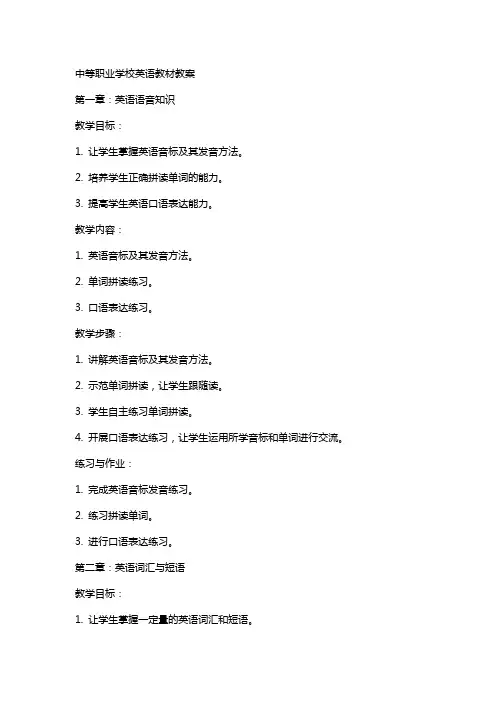
中等职业学校英语教材教案第一章:英语语音知识教学目标:1. 让学生掌握英语音标及其发音方法。
2. 培养学生正确拼读单词的能力。
3. 提高学生英语口语表达能力。
教学内容:1. 英语音标及其发音方法。
2. 单词拼读练习。
3. 口语表达练习。
教学步骤:1. 讲解英语音标及其发音方法。
2. 示范单词拼读,让学生跟随读。
3. 学生自主练习单词拼读。
4. 开展口语表达练习,让学生运用所学音标和单词进行交流。
练习与作业:1. 完成英语音标发音练习。
2. 练习拼读单词。
3. 进行口语表达练习。
第二章:英语词汇与短语教学目标:1. 让学生掌握一定量的英语词汇和短语。
2. 培养学生正确运用词汇和短语的能力。
教学内容:1. 英语词汇和短语的用法。
2. 词汇和短语的搭配。
教学步骤:1. 讲解词汇和短语的用法。
2. 举例说明词汇和短语的搭配。
3. 学生自主练习运用词汇和短语。
练习与作业:1. 完成词汇和短语练习。
2. 运用所学词汇和短语进行写作或口语表达。
第三章:英语语法教学目标:1. 让学生掌握基本的英语语法知识。
2. 培养学生正确运用语法知识的能力。
教学内容:1. 英语语法的基本规则。
2. 语法在实际语境中的应用。
教学步骤:1. 讲解英语语法的基本规则。
2. 举例说明语法在实际语境中的应用。
3. 学生自主练习语法知识。
练习与作业:1. 完成语法练习。
2. 运用所学语法知识进行写作或口语表达。
第四章:英语阅读理解教学目标:1. 提高学生的英语阅读能力。
2. 培养学生获取和处理信息的能力。
教学内容:1. 阅读理解的技巧。
2. 不同类型阅读材料的特点。
教学步骤:1. 讲解阅读理解的技巧。
2. 分析不同类型阅读材料的特点。
3. 学生自主练习阅读理解。
练习与作业:1. 完成阅读理解练习。
2. 阅读不同类型的英语材料,提高阅读能力。
第五章:英语写作与口语表达教学目标:1. 提高学生的英语写作能力。
2. 培养学生流利的英语口语表达能力。
英语听说课教学设计参考教案3篇
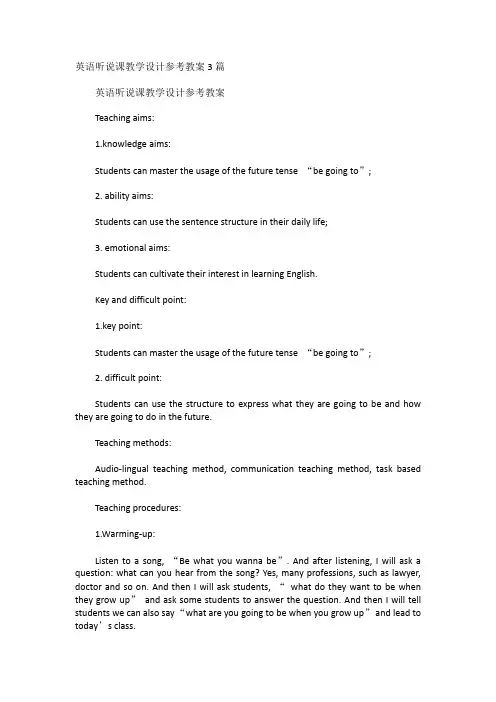
英语听说课教学设计参考教案3篇英语听说课教学设计参考教案Teaching aims:1.knowledge aims:Students can master the usage of the future tense “be going to”;2. ability aims:Students can use the sentence structure in their daily life;3. emotional aims:Students can cultivate their interest in learning English.Key and difficult point:1.key point:Students can master the usage of the future tense “be going to”;2. difficult point:Students can use the structure to express what they are going to be and how they are going to do in the future.Teaching methods:Audio-lingual teaching method, communication teaching method, task based teaching method.Teaching procedures:1.Warming-up:Listen to a song, “Be what you wanna be”. And after listening, I will ask a question: what can you hear from the song? Yes, many professions, such as lawyer, doctor and so on. And then I will ask students, “what do they want to be when they grow up”and ask some students to answer the question. And then I will tell students we can also say “what are you going to be when you grow up”and lead to today’s class.2. Pre-listening:I will show some pictures on the PPT, the first picture is about reporter and the second picture is about the article. I will write down the two words on the blackboard and then I will ask the students to read after me.3. While-listening:I will ask students to listen to the radio for the first time and then match the sentence with the picture on the ppt. The first picture is about the reporter, thee second picture is about writing magazines and the third picture is about Shanghai.Then I will ask students to listen to the radio for the second time and after listening, I will ask them to answer three questions on the blackboard, the first one is “What is he going to do when he grows up”, the second one is “how is he going to do for that”and the third one is “where is he going to work”.Lastly, I will ask students to listen to the radio for the third time and they need to read after the radio. And then I will divide the students into two groups, group A acts as A, and group B acts as B, and read the passage.4. Post-listeningWe will play a game called “hot potato”. When the music begins to play, students need to pass the flower. And when the music stops, the students who is holding the flower need to answer the question about “what is he going to do when he grows up, how is he going to do for that or where is he going to work”.And then we will have a group work, four students as a group and students need to make a survey about what is their group members going to be, how is he or she going to do for that and where is he going to work. Five minutes later, I will ask some groups to show their report.5. Summary and homeworkI will ask students to read the passage to summarize what we have learned today. After class, they need to search more information about the job they want to do.Blackboard designWhat are you going to be when you grow up?How are you going to do for that?Where are you going to work?英语听说课教学设计参考教案一、《英语课程标准》对初中阶段听、说的技能要求准确定位教学目标和宏观把握教学设计的依据是《课标》中规定的各级目标,教师要全面了解各学段的目标,以使自己在教学设计中能更好、更准确地把握。
中职英语教学设计一等奖jobs
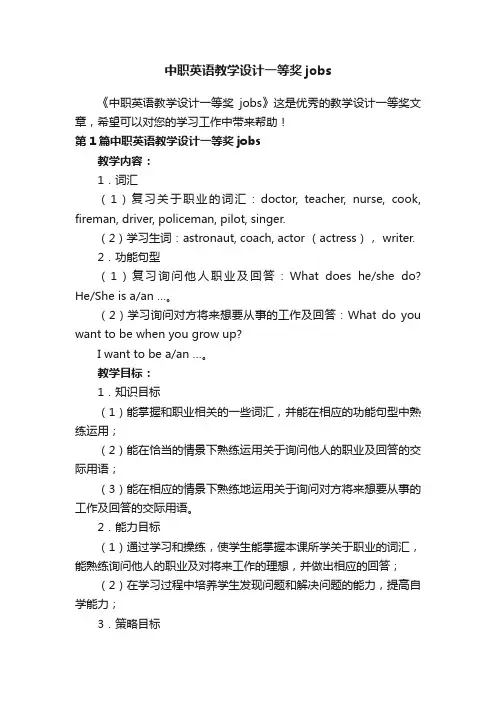
中职英语教学设计一等奖jobs《中职英语教学设计一等奖jobs》这是优秀的教学设计一等奖文章,希望可以对您的学习工作中带来帮助!第1篇中职英语教学设计一等奖jobs教学内容:1.词汇(1)复习关于职业的词汇:doctor, teacher, nurse, cook, fireman, driver, policeman, pilot, singer.(2)学习生词:astronaut, coach, actor (actress), writer.2.功能句型(1)复习询问他人职业及回答:What does he/she do? He/She is a/an …。
(2)学习询问对方将来想要从事的工作及回答:What do you want to be when you grow up?I want to be a/an …。
教学目标:1.知识目标(1)能掌握和职业相关的一些词汇,并能在相应的功能句型中熟练运用;(2)能在恰当的情景下熟练运用关于询问他人的职业及回答的交际用语;(3)能在相应的情景下熟练地运用关于询问对方将来想要从事的工作及回答的交际用语。
2.能力目标(1)通过学习和操练,使学生能掌握本课所学关于职业的词汇,能熟练询问他人的职业及对将来工作的理想,并做出相应的回答;(2)在学习过程中培养学生发现问题和解决问题的能力,提高自学能力;3.策略目标(1)帮助学生学会与人合作,共同完成学习任务;(2)帮助学生学会观察生活中标的.英语,学会借助词典来学习。
4.其他目标(1)在学习职业名称的过程中了解“感动中国的2003年度人物”,潜移默化地为学生树立榜样;(2)在小组学习和帮助他人学习的同时,培养学生乐于助人,热爱集体的良好品质;(3)通过多种形式的游戏和活动,激发学生英语学习兴趣。
教学重点:1.重点词汇:astronaut, coach, actor (actress), writer.2.重点句型:What do you want to be? I want to be a/an …。
中职英语设计课件课件比赛教学教案获奖futurelife听说课
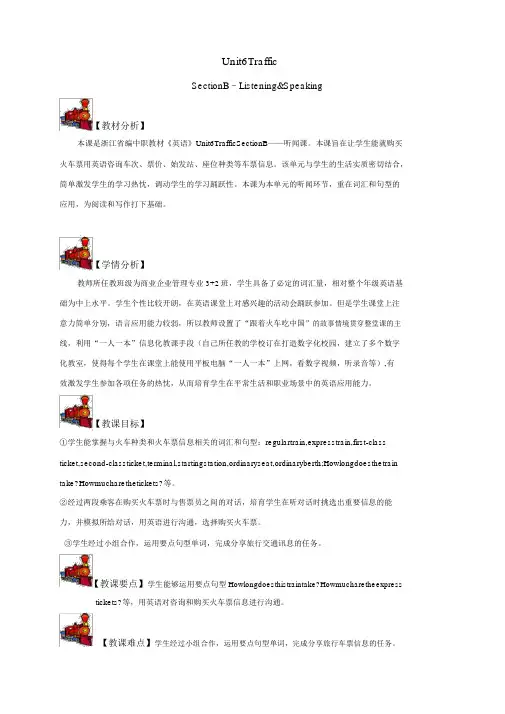
Unit6TrafficSectionB–Listening&Speaking【教材分析】本课是浙江省编中职教材《英语》Unit6TrafficSectionB——听闻课。
本课旨在让学生能就购买火车票用英语咨询车次、票价、始发站、座位种类等车票信息。
该单元与学生的生活实质密切结合,简单激发学生的学习热忱,调动学生的学习踊跃性。
本课为本单元的听闻环节,重在词汇和句型的应用,为阅读和写作打下基础。
【学情分析】教师所任教班级为商业企业管理专业3+2班,学生具备了必定的词汇量,相对整个年级英语基础为中上水平。
学生个性比较开朗,在英语课堂上对感兴趣的活动会踊跃参加。
但是学生课堂上注意力简单分别,语言应用能力较弱,所以教师设置了“跟着火车吃中国”的故事情境贯穿整堂课的主线,利用“一人一本”信息化教课手段(自己所任教的学校订在打造数字化校园,建立了多个数字化教室,使得每个学生在课堂上能使用平板电脑“一人一本”上网,看数字视频,听录音等),有效激发学生参加各项任务的热忱,从而培育学生在平常生活和职业场景中的英语应用能力。
【教课目标】①学生能掌握与火车种类和火车票信息相关的词汇和句型:regulartrain,expresstrain,first-class ticket,second-classticket,terminal,startingstation,ordinaryseat,ordinaryberth;Howlongdoesthetrain take?Howmucharethetickets?等。
②经过两段乘客在购买火车票时与售票员之间的对话,培育学生在听对话时挑选出重要信息的能力,并模拟所给对话,用英语进行沟通,选择购买火车票。
③学生经过小组合作,运用要点句型单词,完成分享旅行交通讯息的任务。
【教课要点】学生能够运用要点句型Howlongdoesthistraintake?Howmucharetheexpresstickets?等,用英语对咨询和购买火车票信息进行沟通。
中职院校教师职业大赛英语教案
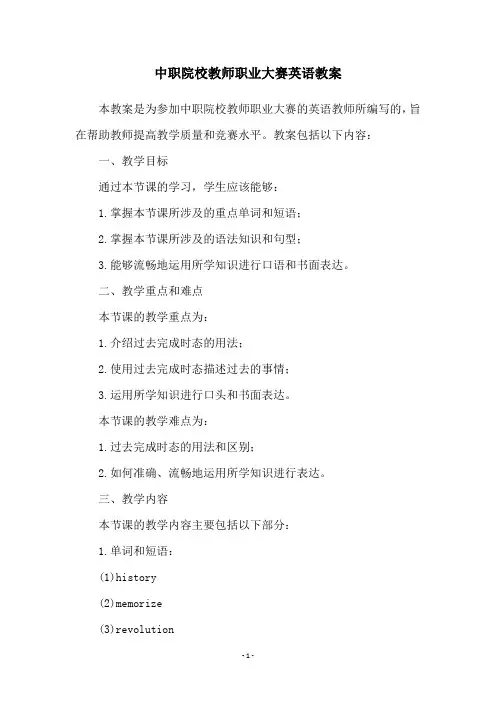
中职院校教师职业大赛英语教案本教案是为参加中职院校教师职业大赛的英语教师所编写的,旨在帮助教师提高教学质量和竞赛水平。
教案包括以下内容:一、教学目标通过本节课的学习,学生应该能够:1.掌握本节课所涉及的重点单词和短语;2.掌握本节课所涉及的语法知识和句型;3.能够流畅地运用所学知识进行口语和书面表达。
二、教学重点和难点本节课的教学重点为:1.介绍过去完成时态的用法;2.使用过去完成时态描述过去的事情;3.运用所学知识进行口头和书面表达。
本节课的教学难点为:1.过去完成时态的用法和区别;2.如何准确、流畅地运用所学知识进行表达。
三、教学内容本节课的教学内容主要包括以下部分:1.单词和短语:(1)history(2)memorize(3)revolution(4)government(5)independence2.语法知识:(1)过去完成时态的用法和区别;(2)使用过去完成时态描述过去的事情。
3.教学活动:(1)听力练习:学生听老师朗读一篇文章,并回答相关问题;(2)词汇练习:学生根据上下文理解单词的含义,并运用单词进行语境填空;(3)语法练习:学生掌握过去完成时态的用法和区别,并运用所学语法进行句子翻译;(4)口语训练:学生通过对话和小组讨论等形式进行口语实践,提高口语表达能力。
四、教学评估本节课的教学评估主要包括以下方面:1.听力理解:学生听老师朗读一篇文章,并回答相关问题;2.词汇掌握:学生根据上下文理解单词的含义,并运用单词进行语境填空;3.语法应用:学生掌握过去完成时态的用法和区别,并运用所学语法进行句子翻译;4.口语表达:学生通过对话和小组讨论等形式进行口语实践,提高口语表达能力。
中职英语听说课教学设计与实践
中职英语听说课教学设计与实践发表时间:2017-11-09T15:39:28.553Z 来源:《教育学文摘》2017年11月总第245期作者:郑伊绚[导读] 语言技能的教学是中职英语教学的重要组成部分,听与说的技能在语言技能训练中通常处于首要地位,是语言“四会”技能的基础。
——以Unit 9《Everything is made in China!》为例◆郑伊绚广东省汕头市鮀滨职业技术学校515000根据《中等职业学校英语教学大纲》中提出的要求:“中等职业学校英语课程要在九年义务教育基础上,帮助学生进一步学习英语基础知识,培养听、说、读、写等语言技能,初步形成职场英语的应用能力。
”语言技能的教学是中职英语教学的重要组成部分,听与说的技能在语言技能训练中通常处于首要地位,是语言“四会”技能的基础。
对于中职学生来说,掌握一定的听、说技能,是形成其职场英语应用能力的一个重要方面,对其未来职业的发展具有重要的作用。
那么如何开展有效的中职英语听说课教学设计与实践,有效地提高学生的听说能力呢?提高听说课教学的有效性,实现预期的教学目标,关键在于有效的教学设计。
为了切实提高听说课教学的有效性,我针对Unit 9 《Everything is made in China》的听说课进行了如下设计与实践:一、教学设计1.设计基本思路根据学生的实际情况并结合本单元的话题和本堂课的主要内容,力争实现教学目标的合理性及较强的可操作性,创设出与学生生活紧密联系的教学情境,搭建以词汇和句型为主干的教学支架,设计形式多样、贴近学生实际生活的语言实践活动,引导、鼓励和帮助学生对所学知识进行有效的巩固、延伸和运用,促进学生语言综合运用能力的全面发展。
2.教材分析本节听说课的教学内容为高等教育出版社《英语2(基础模块)》Unit 9 《Everything is made in China!》中的Listening and Speaking,主要内容是为两个有关物品的材料、产地及用途等的对话,并参照范例表演对话,讨论物品的材料、产地及用途。
中职英语教学设计教案
中职英语教学设计教案第一章:教学目标1.1 知识目标了解英语的基本语法和词汇。
能够进行简单的日常英语对话。
1.2 技能目标能够听懂并正确发音英语单词和句子。
能够阅读并理解简单的英语文章。
1.3 情感目标培养对英语学习的兴趣和积极性。
增强自信心,敢于开口说英语。
第二章:教学内容2.1 词汇教学学习常用的英语单词和短语。
通过图片和实物进行词汇教学,提高学生的记忆能力。
2.2 语法教学学习基本的英语语法规则。
通过例句和练习,让学生掌握语法知识。
2.3 对话教学学习简单的日常英语对话。
通过角色扮演和小组讨论,提高学生的口语表达能力。
第三章:教学方法3.1 直接法通过图片、实物和动作,直接展示英语单词和句子的意义。
引导学生通过观察和思考,理解和记忆英语知识。
3.2 情境教学法创设真实的语言环境,让学生在特定的情境中学习英语。
通过模拟真实的日常场景,进行对话练习和角色扮演。
3.3 任务型教学法设计具有挑战性和实际意义的任务,让学生参与其中。
通过完成任务,提高学生的综合语言运用能力。
第四章:教学评价4.1 课堂评价通过观察学生的课堂表现,了解他们的学习状态和进步。
通过提问和回答,检查学生对英语知识的理解和运用能力。
4.2 作业评价布置适量的作业,检查学生对英语知识的学习效果。
对学生的作业进行及时的批改和反馈,指导他们纠正错误。
4.3 考试评价定期进行英语考试,评估学生的学习成果和水平。
根据考试结果,对学生的学习情况进行总结和分析,制定下一步的教学计划。
第五章:教学资源5.1 教材选择适合中职学生的英语教材,提供系统的学习内容。
利用多媒体教材和在线资源,增加学习的趣味性和互动性。
5.2 教学工具使用投影仪和电脑等多媒体设备,进行教学展示和演示。
利用语音识别软件和在线翻译工具,帮助学生纠正发音和理解语言。
5.3 教学资源库建立丰富的教学资源库,包括单词卡片、对话剧本、练习题等。
鼓励学生自主学习,提供相关的学习资料和参考书籍。
中职英语教学设计教案
中职英语教学设计教案第一章:教学目标1.1 知识目标让学生掌握英语教学的基本理论和方法。
让学生了解中职英语教学的目标和任务。
让学生了解英语教学设计的基本流程。
1.2 技能目标培养学生具备英语教学设计的能力。
培养学生具备英语教学评价的能力。
培养学生具备英语教学实施的能力。
1.3 情感目标培养学生对英语教学的兴趣和热情。
培养学生具备团队合作的精神。
培养学生具备创新和进取的态度。
第二章:教学内容2.1 教学理论介绍英语教学的基本理论,包括语法翻译法、直接法、交际法等。
介绍中职英语教学的理论基础,包括职业教育理论、英语教育心理学等。
2.2 教学目标阐述中职英语教学的目标和任务,包括培养学生具备基本的英语听说读写能力、培养学生的跨文化交际能力等。
2.3 教学设计介绍英语教学设计的基本流程,包括分析学习者需求、确定教学目标、设计教学活动等。
第三章:教学方法3.1 教学策略介绍英语教学的常用策略,包括任务型教学法、情境教学法、分组合作教学法等。
3.2 教学媒体介绍英语教学的常用媒体,包括多媒体教学、网络教学、实物教学等。
3.3 教学评价介绍英语教学评价的方法,包括笔试、口试、课堂观察等。
第四章:教学实施4.1 教学计划制定英语教学的计划,包括教学内容、教学时间、教学方法等。
4.2 教学活动设计英语教学的活动,包括课堂讲解、小组讨论、角色扮演等。
4.3 教学反馈收集教学反馈,包括学生反馈、同行评价等,并进行教学反思。
第五章:教学评价与反思5.1 教学评价对教学过程进行评价,包括教学目标的达成情况、教学方法的有效性等。
5.2 教学反思对教学过程进行反思,包括教学设计的合理性、教学实施的效果等,并提出改进措施。
第六章:教学计划6.1 学期教学计划制定学期英语教学计划,明确学期教学目标、教学内容、教学方法、教学评价等。
6.2 单元教学计划制定单元英语教学计划,明确单元主题、教学目标、教学内容、教学活动等。
6.3 课时教学计划制定课时英语教学计划,明确课时教学目标、教学内容、教学方法、教学评价等。
中职英语获奖说课稿
中职英语获奖说课稿Good morning。
XXX。
I will be presenting a teaching plan for Unit 8."Is Life Fair?" from the Basic Module of English for nal n。
published by the Language Teaching and Research Press。
I will be covering five aspects: teaching materials。
teaching methods。
teaching process。
board design。
XXX.XXX:1.Analysis of the teaching content and the status of the teaching materials:XXX。
humanity。
n。
topic。
and practicality。
The main theme of the unit is "Brave it out," and the focus is on learning related phrases and XXX and process n。
The content revolves around the topic of whether life is fair。
using Patrick's story of perseverance despite his physical disabilities.2.XXX: Reading3.Lesson Plan: 2 class ds4.Issues: Large amount of new vocabulary。
XXX5.Status and Role: Undertaking the task of language input for this unitStudent Analysis:1.Knowledge Reserve: Possessing basic XXX.2.Student Characteristics: The majority of students in the class are girls who enjoy imitating and performing。
- 1、下载文档前请自行甄别文档内容的完整性,平台不提供额外的编辑、内容补充、找答案等附加服务。
- 2、"仅部分预览"的文档,不可在线预览部分如存在完整性等问题,可反馈申请退款(可完整预览的文档不适用该条件!)。
- 3、如文档侵犯您的权益,请联系客服反馈,我们会尽快为您处理(人工客服工作时间:9:00-18:30)。
Unit 6 TrafficSection B – Listening &Speaking【教材分析】本课是浙江省编中职教材《英语》Unit 6 Traffic Section B——听说课。
本课旨在让学生能就购买火车票用英语询问车次、票价、始发站、座位类型等车票信息。
该单元与学生的生活实际紧密结合,容易激发学生的学习热情,调动学生的学习积极性。
本课为本单元的听说环节,重在词汇和句型的应用,为阅读和写作打下基础。
【学情分析】教师所任教班级为商业企业管理专业3+2班,学生具备了一定的词汇量,相对整个年级英语基础为中上水平。
学生个性比较活泼,在英语课堂上对感兴趣的活动会积极参与。
但是学生课堂上注意力容易分散,语言应用能力较弱,因此教师设置了“跟着火车吃中国”的故事情境贯穿整堂课的主线,利用“一人一本”信息化教学手段(本人所任教的学校正在打造数字化校园,建立了多个数字化教室,使得每个学生在课堂上能使用平板电脑“一人一本”上网,看数字视频,听录音等), 有效激发学生参与各项任务的热情,从而培养学生在日常生活和职业场景中的英语应用能力。
【教学目标】①学生能掌握与火车种类和火车票信息有关的词汇和句型:regular train, express train, first-class ticket, second-class ticket, terminal, starting station, ordinary seat, ordinary berth; How long does the train take? How much are the tickets?等。
②通过两段乘客在购买火车票时与售票员之间的对话,培养学生在听对话时筛选出重要信息的能力,并模仿所给对话,用英语进行交流,选择购买火车票。
③学生通过小组合作,运用重点句型单词,完成分享旅行交通信息的任务。
【教学重点】学生能够运用重点句型How long does this train take? How much are the express tickets?等,用英语对询问和购买火车票信息进行交流。
【教学难点】学生通过小组合作,运用重点句型单词,完成分享旅行车票信息的任务。
【教学总揽】I. Lead-in Video 视频引出“坐着火车吃中国”的主题“舌尖上的美食”视频片段,激发学生的兴趣,引出“坐火车”这一主线,明确本堂课的教学目标将围绕“坐火车”展开; 以图学词,更直观,趣味,生动。
II. Presentation PicturesIII. Practice Information gap搭建information gap 攻破句型重点information gap攻克重点:如何询问火车票信息。
为学生掌握句型学会分享旅行车票信息作好铺垫。
IV. Listening and speaking Audios听说有机结合提取有效信息通过听两段对话,筛选出重要信息,并记录细节,完成火车票信息。
同时,模仿所给对话,运用对话中的重点句型,模仿真实情景,用英语询问并购买火车票。
V. Expanding Group work突破难点加强语言应用能力Group work突破难点:在跟着火车吃中国的真实情境中,根据对美食的不同爱好把学生分组,“一人一本”,现场上网查询旅行车票信息并针对组内学生的个性化要求,完成购买火车票并能用英语阐述与交流,鼓励学生自主学习与合作学习相结合。
VI. Homework Information Technology运用信息化手段设计分层作业分层作业,降低难度,课后利用微信在线小组分享旅行车票信息。
【教学过程】Step One Lead-in1.美食视频导入,引出“坐火车”话题After a video of A bite of China, ask students:It’s a pity that these foods are located in different cities. How can we get to different cities to enjoy delicious food?【设计意图】创设“跟着火车吃中国”的故事情境,渲染美食与旅行氛围,自然引入火车主题。
营造了轻松愉快的学习氛围。
视频中出现的四个地方和四样美食同时又是最后一个任务的铺垫。
Step Two Presentation1. 火车种类比较,图片导入生词Ask students to guess Which is the fastest train? according to four train numbers. Use Pictures topresent the new words.Which is the fastest train?D 3211 T 32 G 7366 K1271< 250 KM/H Express < 300 KM/H Express < 140 KM/H Regular< 120 KM/H RegularPresentation【设计意图】根据火车车号猜测它们的速度排名,图片导出生词regular train 和express train。
通过对车次首字母分别为G(高铁),D(动车),T(特快),K(快速)的认识,丰富学生的生活常识。
2.介绍车票信息,熟悉相关生词。
Get Ss to name different seats in trains and identify information on a train ticket, such as train number, starting sation, terminal, departure time, ticket price. Use pictures to present new words.Seats in TrainsOrdinary seatOrdinary Berth (铺)Second-classFirst-class TrainNo.StartingStationTerminal DepartureTimeType ofSeatTicketPriceD2290Wenzhou Hangzhou16:34First-class¥174.00【设计意图】让学生根据不同座位的图片来区别不同的火车票类型,并能根据火车票,提取重点信息。
部分图片呈现新词:ordinary seat, ordinary berth, second-class, first-class, starting station, terminal, departure time. 老师用What is the train number? Where is the starting station/ terminal? When does it leave? How much is the ticket? 来提问,为后面的会话活动做好准备。
Step Three Practice搭建信息沟,操练重点句型Ask Ss to complete an information gap to check whether they can identify the information on a ticket by themselves. Student A gets a ticket; Student B needs to use sentences to get information of the ticket. Help them to use the following structure to communicate: What is the train number? Where is the startingstation/ terminal? When does it leave? How much is the ticket?Student A Student B【设计意图】通过information gap, 学生运用本课重点句型How much is the ticket? What is the train number?... 来完成任务。
提供重点句型,降低活动难度,建立学生信心。
信息沟的灵感来自于英语职场应用比赛,一人一卡,通过沟通卡片上的信息模拟真实对话。
在练习目标语言知识点的同时提高了学生的沟通能力和合作学习能力。
Step Four Listening1. 初步听力理解,回答相关问题The teacher tells Ss: Now we have known some background information about trains and we can identify the informa tion on the ticket. But do you know how to buy a ticket in English? Let’s listen to two conversations: My friends Tom and Mrs Brown are buying tickets at a ticket agency. Then ask the Ss to listen to the first dialogue and complete the information of the ticket.2. 再次听力理解,完成表格归纳Listen to the second dialogue and fill in the form.Ticket InformationTerminal: ________________Running time: ______ hours (regular)______ minutes (express)Price of the ticket: RMB ______ (second-class)RMB ______ (first-class)Ticket bought: ________________________Reason of choice: ______________________3. 跟读听力录音,落实语言输出Read after the tape and underline the sentences used to get ticket information and buy a ticket.【设计意图】通过听第一个对话,要求学生筛选出重要信息;而第二个对话则主要训练学生听懂听力材料并能捕捉细节的能力,并能用所获取的细节信息完成表格,为后面说的活动做好语言上的准备;第三步通过跟读听力录音,模仿对话,学生重点学习询问车票信息以及购买车票的句型。
